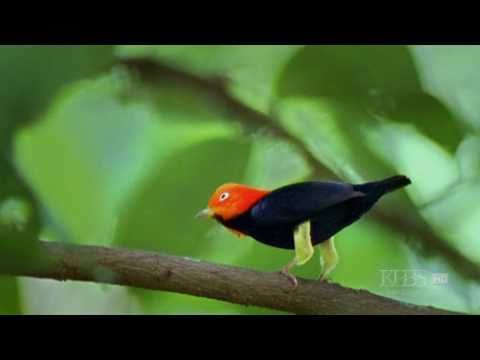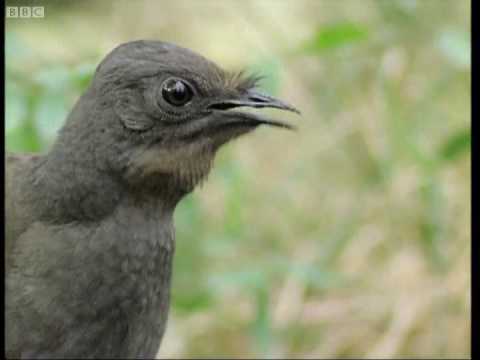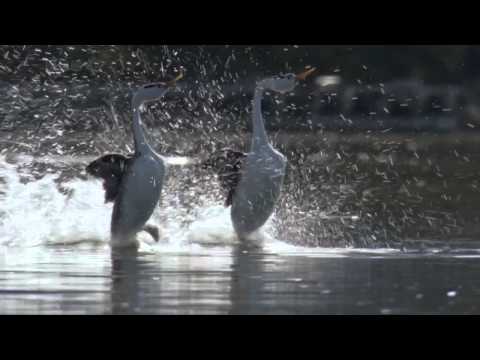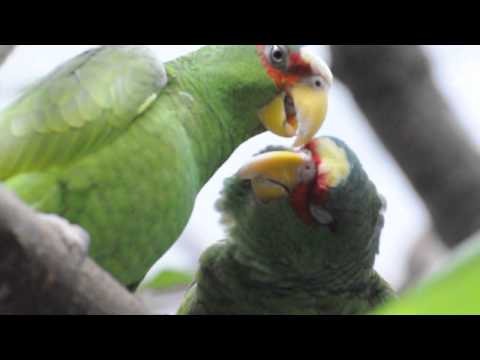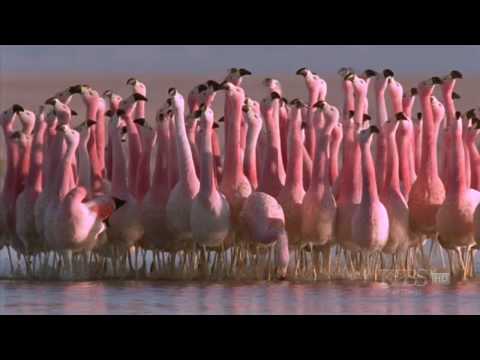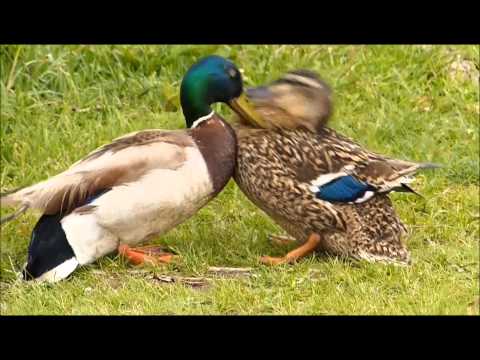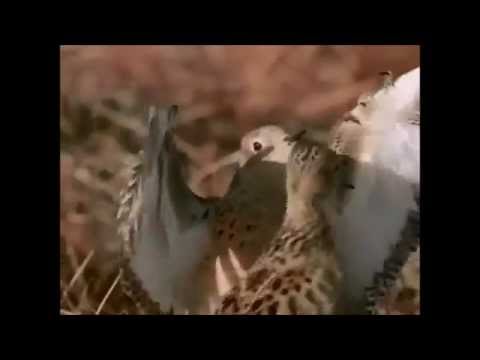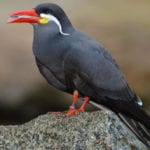However, birds have taken song and movement to the next level—from mimicking a car horn to walking on water. Their fascinating courtship and mating rituals make our own dating attempts seem futile and boring.
10 The Red-Capped Manakin
Who did it first? The red-capped manakin or Michael Jackson? At breeding time, the red-capped manakin chooses a branch as its dance floor and suddenly breaks out in a “moonwalk.” He and other males will stake out a branch called a lek where they’ll put on their performance. Not only will they dance in swift movements but they’ll also produce original beats. These whirrs, buzzes, and clicks all serve to impress the females and warn the other males not to encroach. The moonwalk is just one out of four common displays during courtship. In another, the male will pivot back and forth, showing off his yellow “thighs.” He may also dart back and forth between his perch and the surrounding environment, snapping his wings each time he jumps from his perch. Lastly, he may also embark on a circular flight before returning to his perch. If you’d like to see this little guy perform, head to the rain forests from southern Mexico to western Ecuador.
9 The Greater Roadrunner
Food may be the way to a human man’s heart, but the roles are reversed for greater roadrunners. In one common example of courtship, a male will approach a female with a snake or lizard dangling from its beak. If the female accepts the offer, the two will mate. Like many other birds, greater roadrunners can stretch their range of vocalizations from a low coo to a whirring call. In addition, the male will wag his tail in front of the female while making the cooing sounds. Then, he’ll leap onto her to begin mating. Since it is capable of running up to 25 kilometers per hour (15 mph), the greater roadrunner could flee the scene immediately after mating. However, these birds will often choose a mate for life and share the duties in raising a family. Greater roadrunners (Geococcyx californianus) primarily live in the arid habitats of the southwestern US but have been seen as far south as mainland Mexico.
8 Superb Lyrebirds
A dancer may spend his or her entire childhood and adolescence training for acceptance into Juilliard. Similarly, a male superb lyrebird will spend years practicing an intricate song-and-dance routine before he reaches full maturity. However, the sole purpose of his training is to mate. Watch this video on YouTube Male superb lyrebirds will learn four different song types—A through D. They’ll start off with song A. Then they’ll go back and forth between B and C before finishing with song D. These birds are found in forests west of the Great Dividing Range in Australia. Their performances are comparable to popular 1980s music videos with space and techno beats. With their extraordinary musical talent, these birds can mimic the sound of a car alarm or a chain saw. They’ll even match certain notes to a specific dance move. With his tail over his head, a male superb lyrebird will sing for up to 20 minutes on his display mound. Scientists believe that this sound mimicry is a way for the males to defend their territories. Most importantly, it is a show that many ladies will attend before selecting the mate that is their top choice.
7 Western And Clark’s Grebes
Western grebes and Clark’s grebes are the largest vertebrates that can miraculously walk on water. This walk is more like a form of graceful ballet done in pairs. In about seven seconds, these North American birds will sprint up to 20 meters (65 ft) in groups of two or more. To do this, the grebes will take about 14–20 steps per second. For comparison, humans can only take four or five steps per second. In addition, the grebes will splay their feet out to the side, creating a unique stride which defies gravity. Scientists who were studying these birds in the Pacific Northwest observed that grebes generate 50 percent of the force needed to keep them above water by slapping their feet. The other 50 percent of that force is generated by creating a hydrodynamic lift when diving. Before they burst into dance, the pair will gaze at one another. Then they’ll dive down into the water before emerging to go off as mates. Thought human dating was hard? If a male or female grebe can’t keep up with this water dance, he or she is out.
6 White-Fronted Parrots
It turns out that we are not the only animals who enjoy French kissing. White-fronted parrots (aka spectacled parrots) enjoy kissing each other just as much as we do. At first, they’ll lock their beaks and then begin flicking their tongues back and forth. But suddenly, there’s an appetite-turning twist to the story. The male will regurgitate his food into the female’s mouth as a form of affection. Nothing is more romantic than a little vomit to end a kiss. Native to southern Mexico and Central America, these birds can be seen in dry areas, such as the savanna, rain forests, fruit plantations, and cultivated areas. They are hard chewers and can be quite noisy, especially during breeding season.
5 Andean Flamingos
Andean flamingos (Phoenicoparrus andinus) come to one of the most caustic lakes in the world to breed. In this extreme environment on Salar de Uyuni, the flamingos kick off their mating season with a spectacular group performance. Watch this video on YouTube Together, they will choreograph a masterful courtship dance. They’ll take many tiny steps across the water and flick their necks from side to side. Then they’ll pair off to mate for a monogamous life together. Perhaps, Andean flamingos are attracted to this harsh environment because they know their majestic dance won’t be rudely interrupted by other animals. However, their habitat is frequently disturbed by humans because of increased tourism and the unsustainable mining of salt, sulfur, borax, and other minerals. As a result, the Andean flamingo was officially declared endangered in 2010.
4 Ducks
Although ducks are often featured in children’s books, their mating rituals are not like fairy tales. In fact, their rituals are quite bizarre. Ducks represent the mere 3 percent of birds which have phalli or vaginal tracts. Perhaps it’s evolutionary biology that led female ducks to develop obscure vaginal paths and male ducks to develop phalli up to 38 centimeters (15 in) long. Male ducks will often gang-rape a female to force copulation. The size of their phalli is often considerably larger than their entire bodies. As a defense mechanism, the female ducks’ anatomy allows them to select the right sperm for their eggs. Instead of a simple oviduct, the female ducks possess a complex vaginal tract with different sacs and crannies. To make it even harder for just any duck to successfully eject his sperm into the female, the female’s tract has an anti-corkscrew shape that contrasts with the male’s corkscrew-shaped phallus. Except for extremely cold habitats, ducks are commonly found throughout the world.
3 Finches
Male finches also put on a courtship performance of mixed song and dance. However, female finches have been known to initiate the courtship rituals. For example, a female may present a blade of grass to the male to encourage him to start his performance. Each species has its unique set of courtship behaviors, but males within a species may display similarities. Some of their dance moves include standing tall, puffing out their feathers, begging, rapidly shaking their heads, and brushing beaks. If the male birds are in captivity, they may mate with another species or even try to mate with a male. If the female accepts the male’s proposal, she may tolerate him, mimic his moves, stand confidently, chirp (since she can’t sing), or assume the mating position. If she disapproves, she’ll simply fly away or hiss at him. Since these birds don’t have external genitalia, they have to make contact via their cloacae, which are chambers where their urinary, reproductive, and intestinal tracts meet.
2 Buff-Breasted Sandpiper
Similar to red-capped manakins, male buff-breasted sandpipers will congregate on leks, which are display grounds to attract females. However, each lek will be occupied by a single male and will be several acres away from other leks. To kick off the courtship display, the male will raise one wing to show off his bright white underside. If more than one female approaches, the males will go all out. They’ll raise both of their wings, tilt their bills to the sky, shake their bodies, and release a string of short calls. The males may mate with several females. The female is left to attend to the nest and young. However, the chicks leave their nest only 12 hours after hatching. Although leks are used by more than one bird species, the buff-breasted sandpiper is the only North American shorebird that courts with the lek system. These birds were almost on the brink of extinction in the 1920s due to hunting. Although it’s hard to keep track of their current numbers due to their migratory patterns, conservation efforts are well under way.
1 Peafowl
Female peafowl are clearly not the only ones impressed by the iridescently colorful feathers of a peacock. For centuries, peacock feathers have been reproduced on our clothing, jewelry, paintings, and more. However, research conducted by Purdue researcher Jessica Yorzinski in 2014 suggests a new spin on peafowl mating rituals. Although further research is needed, it looks like the colorful eyespots of peacocks aren’t really attracting the gaze of the females after all. Using eye-tracking technology, Yorzinski found that the peahens were actually spending more time looking at the peacocks’ legs and the lower portions of their feathered trains. What catches the peahens’ attention most is when the male starts turning around and shaking his tail feather. Another misconception is that the term “peacocks” applies to all peafowl. Female peafowl are “peahens,” and the male peafowl are “peacocks.” I am a Jane of all trades. I live for adventure, and if I am not traveling the world, I am reading about its wonders through the works of others. Writing has become a way for me to share my recent discoveries or secrets with my friends and the greater public. I have a few posts on my blog, theelixiroflife.net, that are worthwhile reading! Mother Nature fascinates me the most, and my lifelong passion is to spread the awareness of its lessons, spirit, and mysteries.
